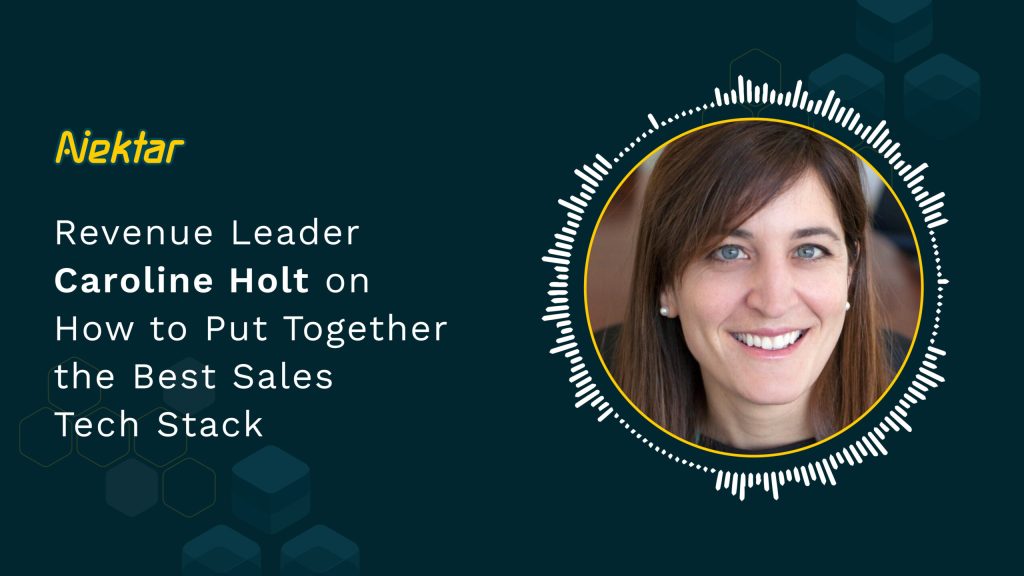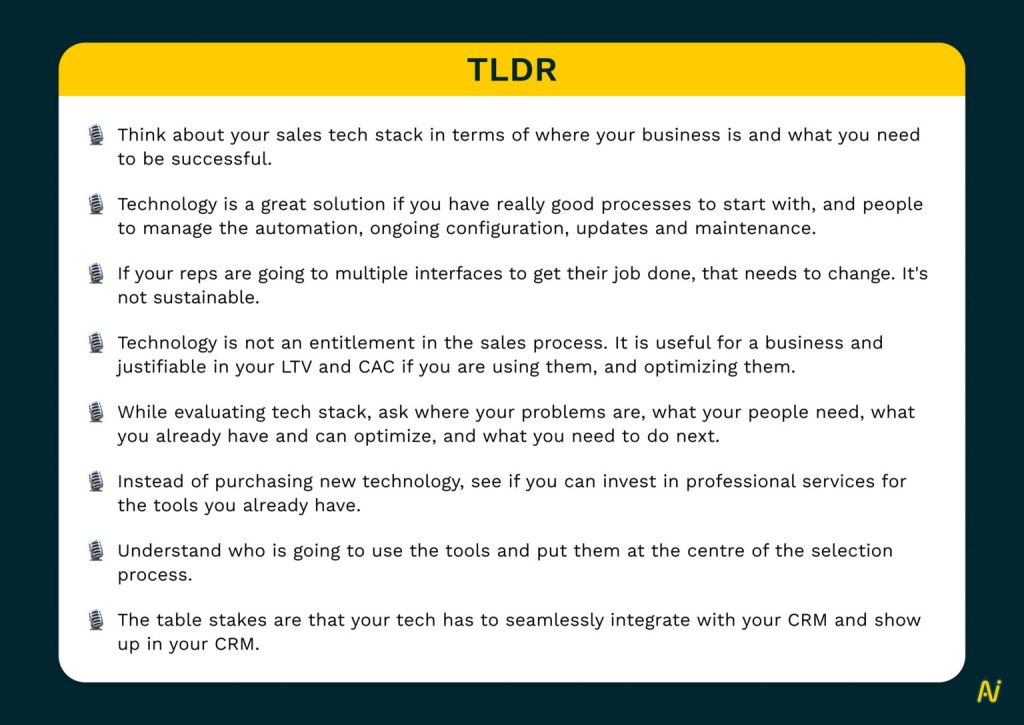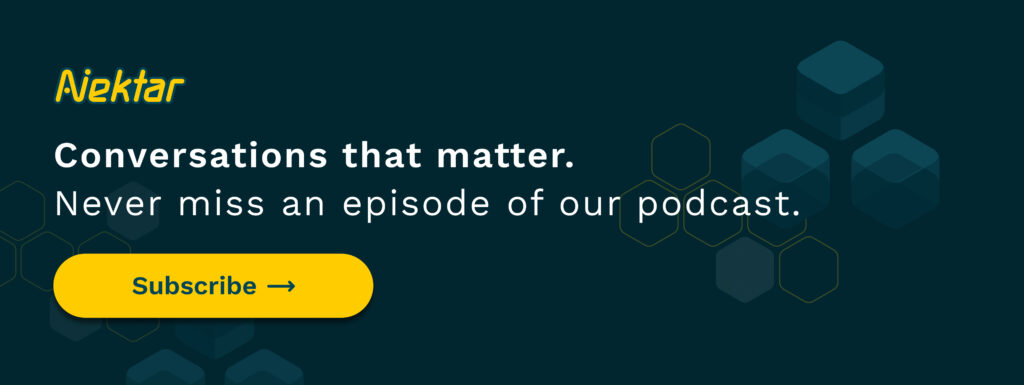
Revenue Leader Caroline Holt on Putting Together the Best Sales Tech Stack
- RevOps
- Sales Techstack
- 10 min
Extracting value from a sales tech stack continues to be a frustrating challenge for revenue leaders. Budget freezes across the board have forced revenue leaders to be more mindful of the tools they add to their tech stack. But it can be a daunting project to undertake with the market being so crowded with tools across multiple categories.
How can revenue leaders select the best tools for their tech stack? How can they derive value from this steep investment? And how can they make their sales teams more productive?
We sat down with Caroline Holt, VP Revenue Training & Enablement at Bonterra, to unpack some of these nuances around creating the best sales tech stack.
Caroline shares some brilliant insights on how revenue leaders can create the best sales tech stack. And make the process more efficient and effective.
If you’re short on time, here is a quick summary of the conversation.

If you enjoy our discussion, check out more episodes of our podcast. You can follow on iTunes, Spotify, YouTube or grab the RSS feed in your player of choice. What follows is a lightly edited transcript of the episode.
The Sales Tech Landscape Has Exploded & Disrupted Sales
Abhijeet: Caroline, thanks for coming on the show.
Caroline: Thank you so much for having me.
Abhijeet: You’ve been in the sales tech industry for quite some time. How have you seen it change over the last few years?
Caroline: Well, it has not only transformed. But it has exploded, right? Technology has disrupted sales. I think the buying process in some cases has not changed over the last 20 years, but the way we sell and the way that the buyer wants to purchase has changed.
So when I think about my role as a BDR early on, I was calling, I was faxing, I was emailing. But I could get to someone typically. And I think in some cases the proliferation of things like cadence tools that allow people to drop somebody into a constant flow of information has actually hindered our ability to get to people that we want, who might actually need what we need to do.
So to the overarching question of how technology has changed, I think in some ways it’s changed in a really incredible way. Because I am an efficiency geek. I like removing friction from the sales process. But I think that sometimes we actually get in our own way because of how we purchase technology.

Technology is going to be great at a foundational level. So the first thing you need is a way to engage with people, whether that is your regular old telephone and email, or whether that is some sort of a dialer tool where you’re capturing that information.
And then you need some place for that information to live. So you need some sort of CRM to be able to capture that information, figure out who you’ve been talking to, what that’s been like, if you’re opening opportunities, what that opportunity looks like. Then you need to figure out what’s actually happening in those calls.
And then that you can analyze a lot of that data over time in terms of what people are saying in aggregate. So our whole roadmap should be focused on it. It provides just a really powerful level of insight.
But I think for a lot of organizations, they don’t ever optimize those parts of the tech stack, and then they start adding new stuff. They either haven’t gotten it right the first time, or they think that that’s table stakes.

So that’s a really simplistic way of thinking about sales technology. But I would say that most organizations need to start with those fundamental pieces and then start thinking about, okay, once we know, now we need to figure out who those prospects are. So what sort of technology is gonna help us identify who those folks are. So how you build that stuff over time becomes really powerful. And then what you do with that data and analytics becomes really powerful over time.
But sometimes people invest really quickly in a lot of technologies, but they never really optimize them for performance. So the other part is just thinking about having what you can actually bite off in terms of tech investments in any given year to be able to do the right thing for your business.
Where is Sales Tech Heading Towards?
Abhijeet: If you don the hat of a sales leader who’s going to spend a hundred dollars this year across the technology stack, how should they go about their investment approach? Where should those a hundred dollars be allocated?
Caroline: So I would say that like everything in enablement or any of the back office operations, it’s where are your problems? So if the business should be investing based on what technology is going to actually help them be more effective, where they’re less effective than they could be today.
So if it’s top of the funnel on lead sources, lead generation, what’s happening with those leads? If it’s understanding how the assets that you have are performing in the market, if it is resourcing – sales reps should be able to capture more of the information of what they’re doing with the market.

I also would say from a prioritization perspective, we’ve been talking about optimization. I would also encourage organizations to think about instead of a new technology, is there a way to invest more in the professional services of the technologies that you have to optimize those and then figure out if that can actually help you close some of the gaps before adding additional systems. Because of change management, right?
Every time you are bringing in a new technology, not only are you taking people who had a different job before the technology was selected, but they have to participate in the selection process. Then they have to come off their day job to identify how you’re going to implement what that process is going to be.
For most technology organizations, they want you to do most of the work on your own, right? And so that’s a lot of time. And then the rollout and that change management can be challenging for an organization to ingest.
We’re now going back to work and other things, right? There’s a lot of change happening in the world. People are saying – I don’t want to work 60, 70 hours a week, right? And so they’re not necessarily going to be excited to add something new. So how do you think about the rollout then? How do you think about the ongoing upskilling and enablement of the new people who weren’t there for the rollout? How do you think about the iteration and the tweaking of the tool? For a tool like a Salesloft or an Outreach or a Groove, you need somebody in that tool every couple of weeks making sure that you’ve got cadences updated. And you’ve got content to be pushing out there. It’s not just a kind of set it and forget it type of thing.
So making sure that you have the people and the accountability to be able to do that. So your question is an awesome one, which is how do you think about prioritizing technology.

Putting Reps at The Center of Tool Evaluation
Abhijeet: More than half of the sales tools don’t see proper adoption. So what would you recommend to revenue leaders around driving adoption up? Because it’s a sunken investment if the reps or the teams are not using tools.
Caroline: That’s right. So tools are great if you have awesome processes and people who can be held accountable for the selection, implementation, and ongoing support and iteration. So the first thing is understanding who is going to use the tool.
There are a lot of great sales people out there. There are also a lot of great tools out there. So understanding who those tools are designed to serve, they need to be at the center of the selection process.

The second is that they play a role in the pilot. A pilot process for the organization helps them understand how this technology is going to work for them, and then helps them build the business case internally if that pilot is done in a way that supports the way that organization would use it on an ongoing basis.
So I think when people use freemium or other things, there’s an opportunity where that person never really understands how it works and so they either have a sour experience or if you don’t have a product led growth strategy where they can upsell right within the product, that’s really hard.
So taking a freemium product and expecting that somebody is using that as a means of seeing whether that’s going to work at scale for 50, 100, 200 or 5,000 – it’s unusual that it will work well. So having some sort of a shorter period, where maybe it’s not the full organization, but a portion of the organization with a path to making sure that the larger organization can use it. Or maybe there’s an opportunity for them to try a little bit of it.
But the rep who is going to be responsible for using a lot of this is actually the one kicking the tires on it. They’re figuring out whether this works. Maybe you’ve got two sets of reps looking at two different solutions, piloting two different solutions at the same time, and making a decision on one after four or five people have used it and seen how it works. So that’s the second part, right, is making sure that there’s some testing period to figure out whether that organization is gonna deliver.
And then third, the people who can champion it internally, right? You know, kind of like the customer experience in a product, right?

Who Should Own Procurement & Management of Sales Tools?
Abhijeet: Great point around focusing on rep experience and usage before those big checks are signed. That brings me to our next question, which is around who manages these tools. Who should be procuring and overseeing management of these tools?
Caroline: So I think enablement itself or operations itself has a lot to do with how the organization structures their functions and their roles. I’ve had both. I’ve been in organizations where I’ve had responsibility for most of the tech stack, or at least most of the sales peripheral tools. I think whoever has responsibility for it, you have to be clear on what those responsibilities are.
So if it’s simply navigating the contracting process, the scope of the relationship, the turning on the users and that sort of thing, I think that that can live in RevOps. Heck, it could live almost anywhere.
But what you need to be clear on is who is responsible for not just the initial rollout, but all the new hires that come in. All the people who four months later aren’t using it. Who’s tracking that data to see who needs ongoing enablement and support? Who’s prioritizing? Who’s the person working with the customer success manager at that organization to understand why that organization is not getting as much out of the tool as they could?
And I think that is either a combination of two people in operations and enablement. It also depends on the level of seniority of the people in those functions. If you have a Salesforce admin who’s responsible for operations and they have never sold before and they’ve done a year or two of kind of Ops trailblazer stuff, they’re not going to be the right person to be managing, negotiating relationships with vendors, getting the most out of those technology tools.
I think this gets back to prioritization. A lot of this gets back to the size of your business, what you’re trying to accomplish in your business, who the players are, their level of seniority, their level of understanding of the sales tech space, and budget.

Like if a professional services arrangement is saying that we’re going to give you 10 hours a month, or 10 hours a quarter, you have to assume that’s somebody who knows the system pretty well. So you need to make sure that you’ve got 15 or 17 hours a quarter. If they’re saying that they’ll give you 10, do you have 17 hours a quarter instead to have somebody on your team fully dedicated to the optimization of that solution or the ongoing support of that? If not, you should be investing in the professional services package because it’s probably significantly less expensive than a fraction of that human capital or the under- utilization of that.
Integrating Sales Tools Across Existing Tech Stack
Abhijeet: Yes, I think, professional services are highly underrated. It works both ways. The vendors get additional revenue and it also drives better adoption. And on the customer side, it’s a great cost-effective way of extracting the best value from the tech investment without incurring a heavy cost from there and in terms of investment into more headcount. A great trade off and a win-win for both parties. Thanks for highlighting that.
So what would be your biggest tip or advice in terms of establishing some of the integrations across the tech stack or different products that have been used in a typical revenue team?
Caroline: Yes, such an important question. When it comes to integrations, I think that your understanding of the tech stack when you go into the initial sales conversations is important. And most organizations will tell you that they can integrate with almost anyone.
The question is – do they have an out of the box integration or are you responsible for building that integration? And if you are an organization like mine right now, if you’re a highly acquisitive organization, or you have multiple business lines that may have different technologies or different instances of the same technology , that can also be a challenge.

I think the second is thinking about how many instances of integrations you may need. So for example, right now we have nine different Salesforce instances. Content management systems can integrate with anything. They can integrate with Salesforce. Oh, we do have HubSpot as well, but they can’t integrate with nine different instances of the same sales tech. They can only do one, right?
I think that’s important as well. So if you are a highly acquisitive business and you’re likely to bring in additional tech to your stack, how are you going to solve it? How are you going to make sure that either those people that you’ve just acquired can move over and on what timeline and how does that impact your contracts?
Or that you stay separate. And what does that mean for your business? Or are there ways that they can integrate or hacks that you have to make sure that the content and information that you need is getting all the way up to that executive leadership team board level.
So then there’s a lot of human capital that goes into trying to put those reports together. When you’ve got disparate businesses, I don’t know if that helps, but I would say those are two of the things as I think about where I am and right now in my career and what I’m trying to work on for my own business.

Abhijeet: Caroline, for being a guest today and sharing all these insights about the sales tech landscape, your journey, and how people can grow their career in enablement. It was wonderful talking with you and learning more about you.
Caroline: Thank you so much. It’s been a pleasure to be here.


Bhaswati
Director of Content Marketing at Nektar.ai, an AI-led contact and activity capture solution for revenue teams. With 11+ years of experience, I specialize in crafting engaging content across blogs, podcasts, social media, and premium resources. I also host The Revenue Lounge podcast, sharing insights from revenue leaders.